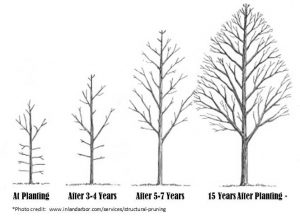The Importance of Structure Pruning Young Trees
It is often said that a well-trained young tree is sure to grow into a well-structured mature tree. Well, actually it isn’t often said but I say it. Many people don’t realize how important it is to structure prune young trees. A lot of undesirable attributes, like codominant leaders and poorly attached limbs, that can lead to high risk failures in mature trees could have been easily and economically corrected when the tree was young.
The Cost of Not Structure Pruning
 Imagine this scenario: A 15-year old eucalyptus tree must be removed because it has become too structurally unsound. It’s located in a difficult to access area and the removal will cost $1,200. The purchase and planting of a replacement tree will cost an additional $1,000 and has the disadvantage of being smaller than the original tree. On the other hand, the issue that necessitated the removal could have been avoided through annual structure pruning of the young tree for a handful of years:
Imagine this scenario: A 15-year old eucalyptus tree must be removed because it has become too structurally unsound. It’s located in a difficult to access area and the removal will cost $1,200. The purchase and planting of a replacement tree will cost an additional $1,000 and has the disadvantage of being smaller than the original tree. On the other hand, the issue that necessitated the removal could have been avoided through annual structure pruning of the young tree for a handful of years:
Structure pruning at $25 x 4 years = $100 vs. $2,200
What is Structure Pruning?
Structure pruning is the practice of selective trimming to promote a strong framework within the tree which will support future growth. Beginning when the tree is around 5 years old, structure pruning should be performed annually on trees that become large at maturity. Ideally, structure pruning encourages a single central leader (or trunk) and regularly spaced, horizontal branches. From the perspective of asset management, structure pruning reduces future maintenance costs and mitigates liability risk by cultivating trees that will be strong and stable at maturity.

It’s a no-brainer! So why do so few people structure prune young trees? It’s often simply a question of routine. The typical modus operandi is for landscapers to include trimming of trees up to a certain height (usually 12 to 15 feet) in their scope of work, and not to turn them over to a tree care company until they become too tall to be pruned from the ground. If this is the case on your property, ask your landscaper whether young trees are being structure pruned under the guidance of an arborist.
While prevention is the best cure for a badly structured tree, don’t lose hope if you already have trees with structural issues or lots of deferred maintenance. Mature trees that have not received structure pruning or appropriate trimming during their life will also benefit from structure pruning.
Talk to your tree care company about young tree pruning practices that will lead to well-structured mature trees and potentially mitigate future liability, or contact us to learn more.
 Shannon Miller, Director of Sales
Shannon Miller, Director of Sales
ISA Certified Arborist WE-9539A
ISA Tree Risk Assessment Qualified (TRAQ)
